Innovative Technology for Emissions-free Driving
Mirai translates as future in Japanese. If there was ever a car on the road fitting the bill as future, it is the 2024 Toyota Mirai Fuel Cell Electric Vehicle (FCEV). Exclusively available in California, Toyota sold 2,737 Mirais in 2023. This is impressive as there are only 55 operating hydrogen fuel stations in the state and the availability of hydrogen is sometimes spotty. For perspective, China, which is far larger than California, has 250 and Japan, which is roughly that same size as California but populated by three times as many people, has 160 stations.
So why the low station numbers, and why only in California? The state has recognized hydrogen-powered cars as part of its drive to zero-out tailpipe emissions (and the resulting dangerous smog) for three decades and helped support the development of vehicles and infrastructure. The hydrogen fueling station network slowly being built out, funded in part with state support that averaged $20 million/year for the past couple decades. In October 2023 Gov. Newsom signed a funding bill to invest $106 million in the construction of additional hydrogen stations through the end of the decade, for the first time backing stations for commercial vehicles as well as passenger cars. The need for more stations is necessary if this fuel is to ever gain consumer acceptance for their everyday vehicles.

For now, Californians have the opportunity to own a very nice electric car powered by compressed hydrogen gas. In its second generation, the 2024 Toyota Mirai makes electricity onboard to drive its electric motor. No plugging in to an electrical outlet. Ever. The fueling process is fast and easy and a FCEV operates exactly like a gasoline-powered car, but with no noise, exhaust fumes or emissions.
A Little History
It is rare when we post a review of a car that is only available in one of the 50 United States, but things are about to change, hopefully creating more demand for hydrogen fuel and stations. The federal government has dropped $7 billion in its “Hydrogen Hubs” program that will create seven regional programs to create clean (fossil fuel-free) hydrogen along with additional infrastructure.
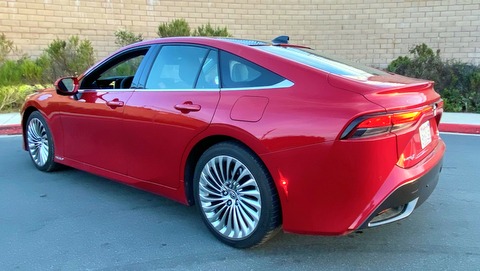
Along with the Mirai, the Hyundai Nexo FCEV (and its predecessor, the Hyundai Tucson FCEV) has been on sale in California since around 2016 and makes-up a part of the total 18,025 FCEVs sold in California. Honda announced recently the CR-V e:FCEV compact crossover will be available combining both hydrogen and a plug-in battery in 2025. (It previously sold the fuel cell only FCX, Clarity FCX and Clarity FCEV.)
Consumers not taking to hydrogen will not mean this method of producing electricity for vehicles is going away. Hydrogen is used in many applications such as forklifts in warehouses, transit buses, as rocket fuel for the U.S space program, and for large semi trucks plying the highways. Toyota (in partnership with Peterbilt and others), Hyundai and Nikola are the early leaders in hydrogen being a fuel source for over-the-road trucks, highlighted by what they are doing at the Port of Long Beach and elsewhere in California. Other major trucks companies, including Daimler and Volvo, are also working on their own hydrogen-fueled trucks.
Producing Electricity from Hydrogen
The electric power comes from oxygen being introduced to a fuel cell filled with compressed hydrogen gas. Through a chemical process, electricity is created to power the motor and (alternately) charge a lithium-ion battery. The by-product of this chemical reaction is water vapor that harmlessly drips from the tailpipe, making the Mirai a zero-emission vehicle. Here are the important propulsion details.
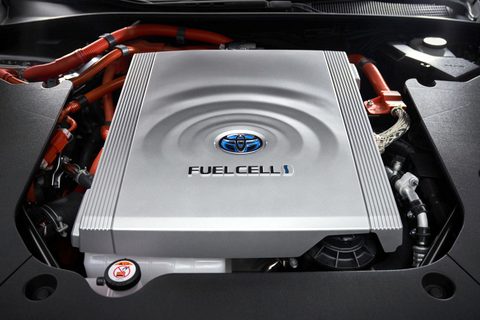
- Single motor driving the rear wheels
- 182 horsepower
- 221 pound-feet of torque
- Power Output: 128 kW
- Three carbon-fiber reinforced hydrogen tanks with a three-layer structure
- Hydrogen Tank Capacity: 5.6 kilograms of compressed hydrogen gas
- Fuel Economy: maximum MPGe
- Mirai Limited: 67 city/64/highway/65 combined
- Mirai XLE: 76 city/71 highway/74 combined
- Driving Range
- Limited: 357 miles
- XLE: 402 miles
Note: MPGe, or miles per gallon equivalent, is a measurement of how efficient a car powered by electricity is, using the same amount of energy as is contained in one gallon of gasoline.
A Luxurious Toyota
The 2024 Mirai, based on the Lexus LS platform, made a giant leap into respectability after a complete redesign in 2021. The exterior, interior comfort, driver safety systems and the ability to go up-to 400 miles on a tank of hydrogen has made a huge difference from the first generation Mirai. See Clean Fleet Reviews at the end of the story.
Silent Running: Hitting the Open Road
Clean Fleet Report drove the 2024 Mirai Limited 242 miles through Southern California. When we took delivery of the Mirai, the dash gauge read 345 miles of estimated range, which means we could have driven from Los Angeles to the Silicon Valley and had a few miles to spare.
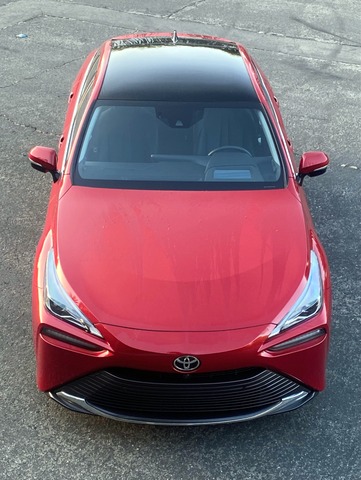
The Mirai’s hydrogen fuel cell system produces smooth linear acceleration with 0-60 times in about 9 seconds, which is not fast as far as electric cars go, but certainly quick enough to merge onto highways and pass big rigs.
The performance was so good, with a near silent driving experience coming from the hydrogen-powered electric motor, it was easy to forget a science project was taking place under the hood. To maximize performance, electricity consumption and driving range, the Mirai has regenerative braking that converts kinetic energy into electric energy and stores it in the battery when applying the brakes or coasting. There are three driver-selectable drive modes of Eco, Normal and Sport. On the open road Eco is the place to be, Sport is for more responsive acceleration and a more responsive steering wheel resulting a better road feel, and Normal is a combination of the two.
The handling will make you want to seek-out corners and curves, testing the front and rear multi-link suspension, the ventilated four-wheel discs and anti-lock brakes. Rear wheel drive, a 50:50 weight balance, and the motor, battery and hydrogen fuel tanks being placed low to the ground under the seats, along with Active Cornering Assist, all contributed to what is a respectable, fine-handling sedan.
Lexus Outside and Inside
The Mirai is the best-looking Toyota sedan. It looks great from any angle. The Lexus design cues take the Mirai upscale, which poses the question was why is it not part of the Lexus line? Toyota says the Mirai is a car for everyone, and not just a luxury car. The consumer wins on this point, being able to own a Toyota with a Lexus hidden underneath.
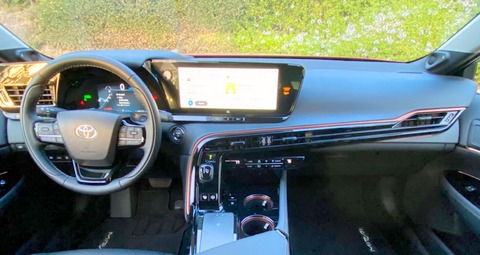
The Mirai Limited interior has top-level design elements with every creature comfort available, including leather, power everything, an excellent sound system, rear side window shades and a power rear window shade. The standard and available advanced driver assist systems (ADAS) are extensive and include the latest safety technology.
Front seats in the XLE have heat and power, with the Limited getting power, heat and ventilation (and memory for the driver position). All seats are covered in SofTex, a synthetic leather seat material designed for wear, easy cleaning and resisting spills. The rear seats in the Limited are heated and ventilated, and rear seat passengers have air vents, a touchscreen for climate and audio controls, and a toggle to control the overhead sunshade.
There is wireless phone charging, selectable eight-color ambient lighting, 3-zone automatic climate control system and a fixed dual panoramic roof.
The 12.3-inch touchscreen houses dynamic navigation, AM/FM, SiriusXM, wireless Apple CarPlay and Android Auto and Amazon Alexa—and the 14-speaker, 1,200-watt JBL premium audio system with subwoofer and a 12-channel amplifier. Connectivity is through multiple USB-C ports. Hands-free telephone is through Bluetooth.
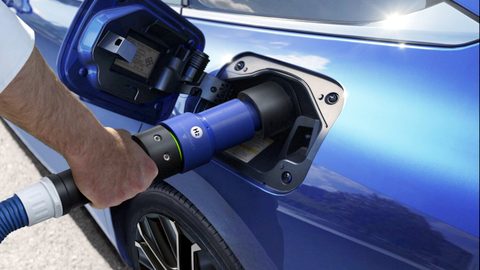
Fueling Experience
The fueling process itself is pretty straight forward and simple. If you can fill a tank with gasoline, then you will have no problems with hydrogen. Once at the station, the fueling process is explained through a video that plays on the pump demonstrating how the nozzle notches into the car, followed by the twisting of a handle to lock the nozzle in place. If there are two pressure options on your pump, you always want to select 70 Bar, which is 10,000 psi. The filling will start and stop for a few seconds at a time, but a complete fill is under five minutes. When removing the nozzle you will notice it is cold because the hydrogen gas is cooled to right around zero degrees Fahrenheit to increase its density, which results in more gas filling the tank. That’s it!
Safety
The 2024 Mirai is well-equipped with the ADAS of the Toyota Safety Sense 2.5+. Active and passive safety features include eight air bags, vehicle stability and traction control and brake assist. The advanced driver pre-collision technology includes lane departure alert, adaptive cruise control and pedestrian detection. Additional safety features include remote keyless entry, push button start/stop and a tire pressure monitoring system.
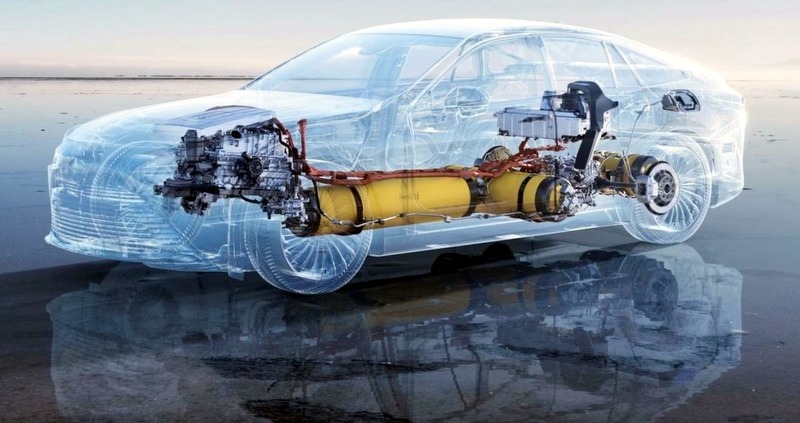
Pricing
The 2024 Mirai comes in two models. These prices include the mandatory $1,095 delivery, processing and handling fee.
- XLE $51,285
- Limited $68,210
The Mirai qualifies for Federal and California state tax credits that could reduce your final cost, and potentially provide a coveted HOV carpool lane sticker.
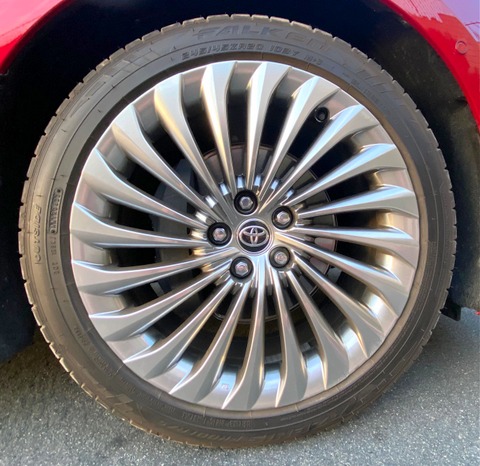
Purchase Incentives
Toyota is also offering these incentives for new owners at the time of our review.
- Price Promotion: $30,000 cash incentive for qualified buyers (as of March 2024. See your dealer for details)
- Interest Rate: 0% APR for 36 or 48 months
- Complementary Fuel
- Purchase: 15,000 miles or six years, whichever comes first
- Lease: 15,000 miles or three years, whichever comes first
- Toyota Rental: A complimentary Toyota rental, up-to 21 days, for original owners during the first three years. This great benefit is important if there comes a time when planning a family vacation that takes you away from the hydrogen fueling station network.
Warranties
- High Voltage Battery – 10 years/150,000 miles
- New Vehicle Warranty – Three years/36,000 miles
- Basic – Three years/36,000 miles
- ToyotaCare Maintenance – Three years/36,000 miles
- Powertrain – Five years/60,000 miles
- Rust Through – Five years/Unlimited miles
- Roadside Assistance – Three years/Unlimited miles
The Ownership Experience
While consumer ownership of a hydrogen fuel cell vehicle has been proven to be safe and reliable, there still are a couple unique considerations to owning a Mirai. It is only sold in California at 11 dealers, six in Northern and five in Southern California, and those are grouped in heavy population areas. With the electric driving range exceeding 400 miles means you don’t necessarily need to live near a dealership, but Toyota will strongly recommend you do.
Considerations
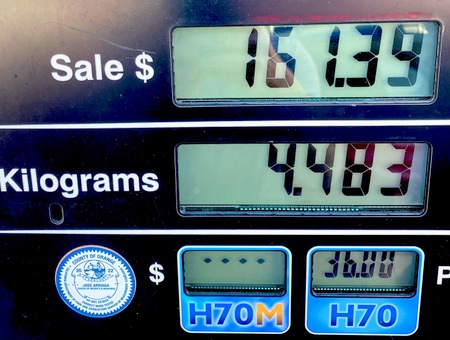
- Hydrogen costs (as of March 2024) $36 per kilogram (kg), so to fill the Mirai’s 5.6 kg tank would be about $202. With a 400-mile driving range, this would be about $.50 per mile just for fuel. This is why the complementary fuel purchase incentive offered by Toyota is so valuable.
- Hydrogen fuel stations, just like electric charging stations, have a spotty record of not being operational at all times. This is why it is crucial to use an availability website, such as the one from the Hydrogen Fuel Cell Partnership.
- Hydrogen prices fluctuate in a broader range than gasoline or electricity. In 2022 it was $16 per kilogram compared to now where it sits around $36 per kilogram.
- Compared to a battery electric car, the cost-to-fuel difference is substantial. The cost to charge an electric car with a 66 kWh battery, with a California average of 19.39 cents per kilowatt-hour (kWh) for electricity, would cost about $12, to drive 300 miles, which is a common all-electric range found on many EVs. With a home charger and solar panels, the cost to charge an EV would be even less. Of course, EV charging can be variable as well, with some public charger rates variable based on time of day or length of stay. Some rates that have been quoted in media studies: Electrify America: $0.48/kWh; Tesla: $0.50/kWh avg.; EVgo: up to $.63/kWh at peak times.
- The Mirai is not a car to be driven outside California.
Observations: 2024 Toyota Mirai Hydrogen Fuel Cell Electric Vehicle (FCEV)
The 2024 Toyota Mirai drives and handles like any other car, actually better than many other cars. It has comparable performance of an electric car (which it should because it is an electric car), is great looking and is emission-free. If you are comparing it to an electric car, then it has the advantage of refilling the full driving range (357-402 miles) in a matter of minutes as opposed to possibly hours. The plus side of owning a Mirai is it is a premium five-passenger sedan, and one you will enjoy driving and spending time in.

The purchase incentives are easily the best Clean Fleet Report has ever seen. With a possible $30,000 off the above prices and the fuel credit, you can drive mostly in-town cost-free. A maintenance-free car for about $21,000 sounds pretty enticing.
Toyota makes a strong case for the hydrogen-powered Mirai to be sitting in your garage, but only if it fits your lifestyle and driving pattern. The last thing they want is a dissatisfied owner that doesn’t understand hydrogen technology, or the cost and availability of hydrogen fuel.
If you are considering buying a midsize sedan, no longer want to be tethered to the gasoline umbilical cord, then quite possibly a Mirai could be a good fit. Go into one of the 11 California Toyota dealers (listed below) that are experts on the Mirai, and learn if this unique car is right for you.
Make sure to opt-in to the Clean Fleet Report newsletter (top right of page) to be notified of all news stories and vehicle reviews.
2017 Mirai review here.
2019 Mirai review here.
Toyota Mirai Dealers: Southern California
Hamer (Mission Hills)
Longo (El Monte)
Toyota Mirai Dealers: Northern California
Stevens Creek (San Jose)
Story by John Faulkner. Photos by John Faulkner and Toyota.

7 thoughts on “Road Test: 2024 Toyota Mirai Limited FCEV”